-
NBS Tasks
Browse topics
- Monetary policy
- Financial market supervision
- Financial stability
- Banknotes and coins
- Payments
- Statistics
- Research
- Legislation
-
Publications
- Activity Report of the NBS Innovation Hub Annual Report Carbon Footprint Report of NBS Climate-related disclosures of NBS non-monetary policy portfolios Economic and Monetary Developments Financial Stability Report Investment Policy Statement of the National Bank of Slovakia Macroprudential Commentary
- Policy Briefs Report on the Activities of the Financial Market Supervision Unit Research Papers: Working and Occasional Papers (WP/OP) Statistical Bulletin Structural Challenges Other publications Sign up for your email notifications about publications
- About the Bank
- Media
- Frequently asked questions
-
For the public
Browse topics
- About the Bank
- Exchange rates and interest rates
- Banknotes and coins
- Payments
- Financial stability
- Financial market supervision
- Statistics
- Legislation
-
Publications
- Activity Report of the NBS Innovation Hub Annual Report Economic and Monetary Developments Financial Stability Report Macroprudential Commentary
- Report on the Activities of the Financial Market Supervision Unit Research Papers: Working and Occasional Papers (WP/OP) Statistical Bulletin Other publications Sign up for your email notifications about publications
- Frequently asked questions
- Media
- Careers
- Contact
National sides of Slovak euro coins
€2
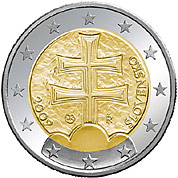
€1
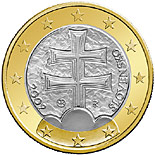
A double cross on three hills as featured in the Slovak coat of arms, one of the state symbols of Slovakia. The cross is set within the central circular field against a relief background of stylised rocks, symbolising the state’s permanence and stability.
Designed by Ivan Řehák.
50 cent
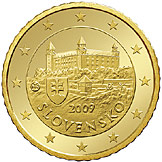
20 cent
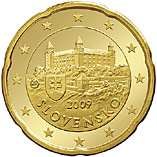
10 cent
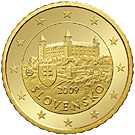
Bratislava Castle, the dominant landmark of Slovakia’s capital city and the country’s most visited national heritage site. The castle design incorporates the Slovak coat of arms, one of the state symbols of Slovakia.
Designed by Ján Černaj and Pavol Károly.
5 cent
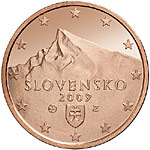
2 cent

1 cent

Krivan
Kriváň in the High Tatra Mountains, a peak associated with significant events in Slovak national history. As the destination for ‘national excursions’ undertaken by followers of Ľudoviť Štúr, Kriváň played a significant role in the 19th century Slovak national revival movement. It was also a base for partisans during the Slovak National Uprising in the latter stages of the Second World War. With such a history, Kriváň has become a symbol of national self-determination and Slovak territory.
Designed by Drahomír Zobek.
Print version – images compressed to ZIP file, size 32 MB.
Format: TIF, resolution: 1814×1814 px (cca 15×15 cm/300 dpi).